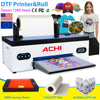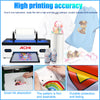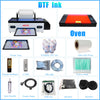What is a UV DTF Printer, and How is it different with DTF Printers?

DTF printing has become increasingly popular in recent years as a cost-effective and easy-to-use method of printing on a variety of materials, including fabrics, plastics, and metals.
However, there are several types of DTF printers on the market, each with its own set of advantages and disadvantages. In this blog post, we'll take a closer look at UV DTF printers and how they differ from other DTF printers.
What is a UV DTF Printer?
A UV DTF printer is a type of DTF printer that uses UV-curable ink instead of traditional water-based ink. This ink is specially formulated to cure quickly when exposed to UV light, allowing for faster printing speeds and more vibrant colors. Additionally, UV-curable ink is more durable and resistant to fading than water-based ink, making it ideal for outdoor or long-term use.

How is a UV DTF Printer Different from Other DTF Printers?
The main difference between a UV DTF printer and other DTF printers is the type of ink used. Traditional DTF printers use water-based ink, which can be prone to fading and bleeding over time. Additionally, water-based ink requires a longer drying time, which can slow down the printing process.
UV DTF printers, on the other hand, use UV-curable ink, which dries almost instantly when exposed to UV light. This allows for faster printing speeds and more vibrant colors, as well as increased durability and resistance to fading.
Another key difference between UV DTF printers and other DTF printers is the type of film used. UV DTF printers require a special type of film that is coated with a UV-sensitive layer.
This layer is activated by the UV light from the printer, allowing the ink to bond with the film and create a durable, long-lasting print.
Traditional DTF printers, on the other hand, use a different type of film that is coated with a water-soluble layer.
This layer is activated by heat, allowing the ink to bond with the film and transfer to the final product.

In other hand , DTF printers require the use of an oven, hot melt powder, and a laminating machine for transfer printing, and can only be used to smooth the surface of objects.
UV DTF printers do not require additional equipment and have multiple functions in one, allowing printing films to be applied to both flat and curved surfaces, even most of kinds of irregular product
Conclusion
In conclusion, UV DTF printers offer several advantages over traditional DTF printers, including faster printing speeds, more vibrant colors, easily &widly using , and increased durability and resistance to fading.
If you're in the market for a DTF printer, it's worth considering a UV DTF printer for your printing needs.
-
Posted in
DTF printer, UV DTF printer




